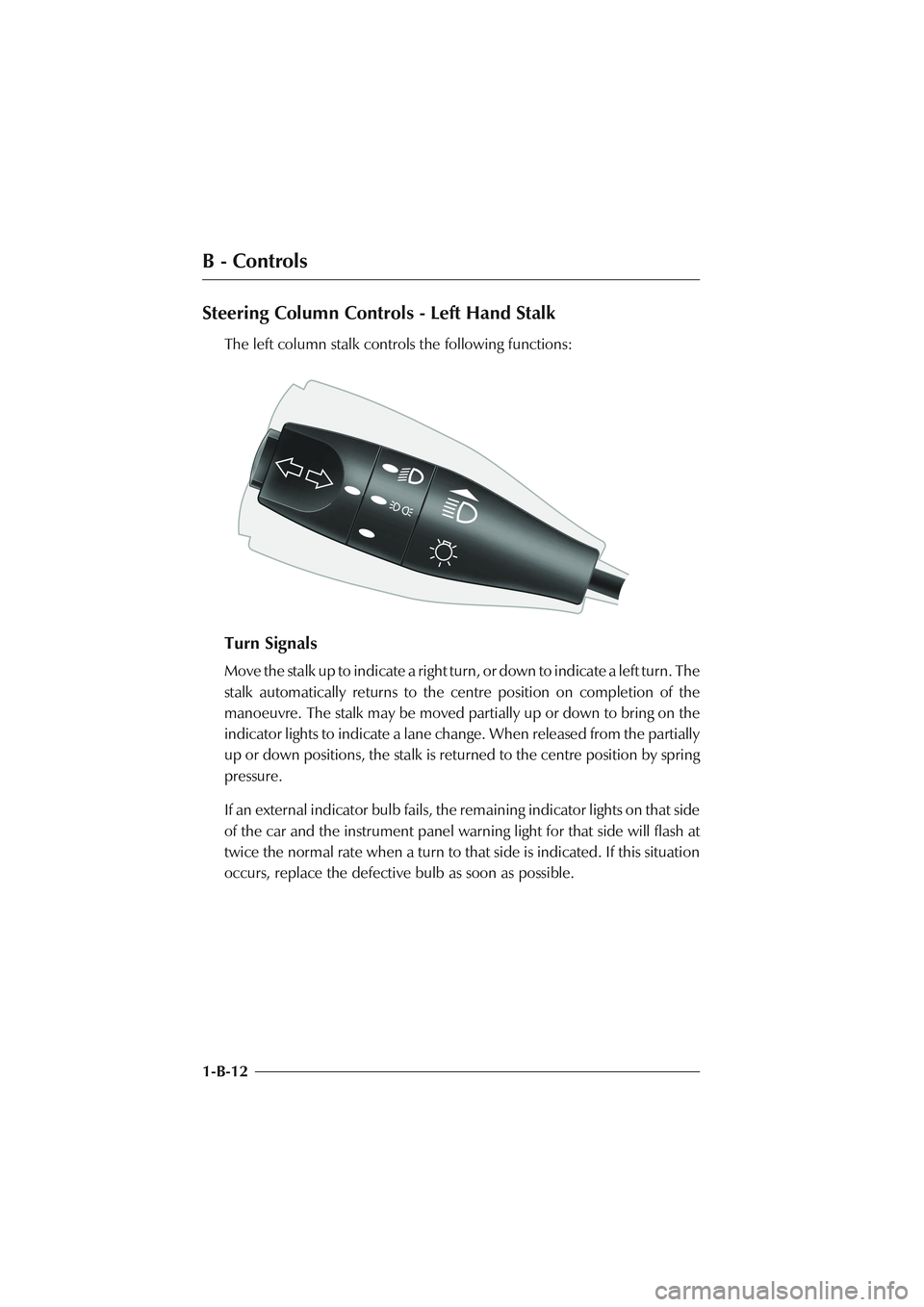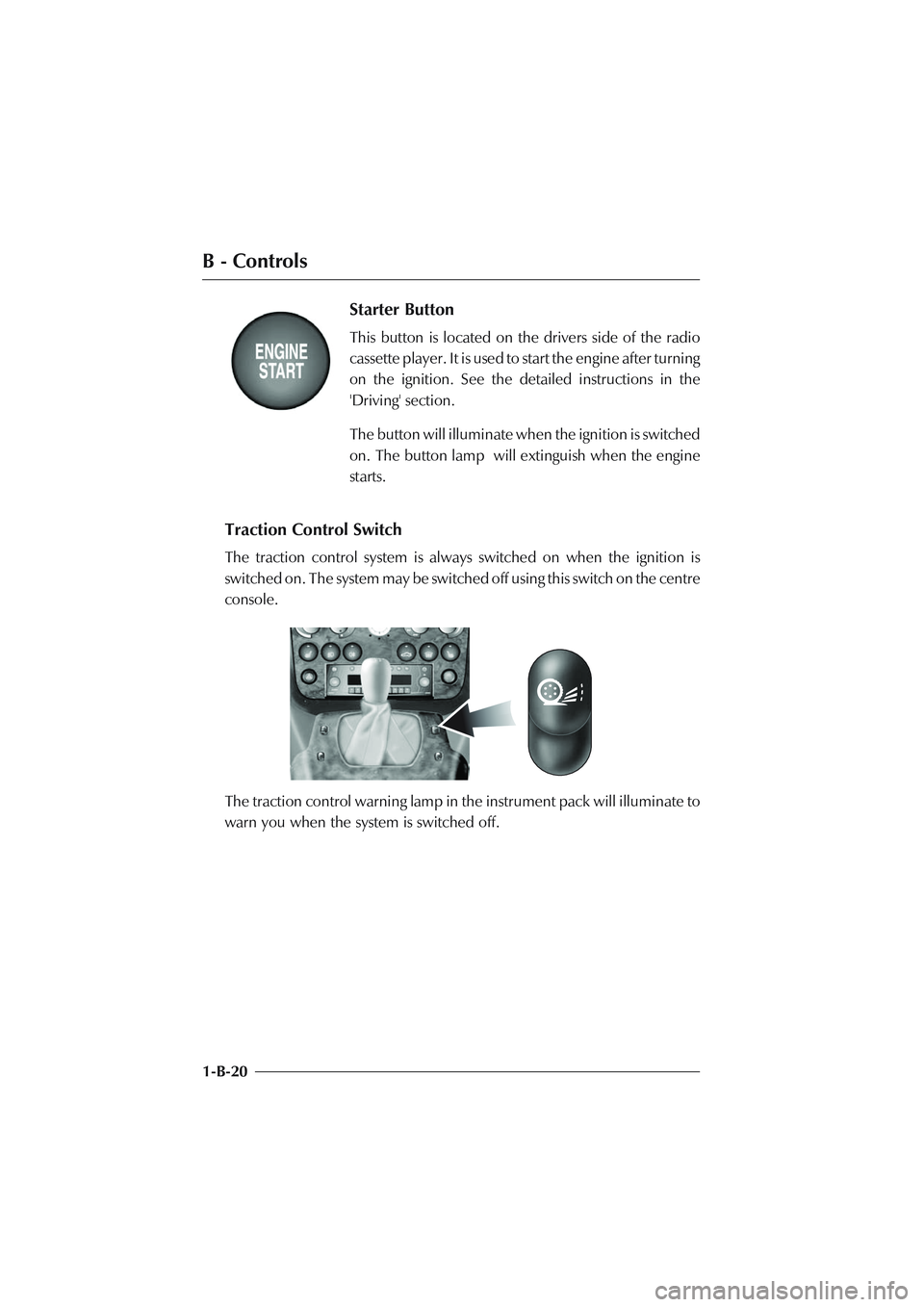warning ASTON MARTIN DB AR1 Q 2003 Owners Guide
[x] Cancel search | Manufacturer: ASTON MARTIN, Model Year: 2003, Model line: DB AR1 Q, Model: ASTON MARTIN DB AR1 Q 2003Pages: 279, PDF Size: 3.77 MB
Page 46 of 279

B - Controls
1-B-10
Instruments
Voltmeter (top left)
Shows the battery voltage when the ignition is turned on and shows the
voltage delivered from the alternator when the engine is running.
Fuel Gauge (bottom left)
The DB AR1 fuel capacity is 82 litres (18 Imp gallons / 21.5 US gallons). The
low fuel warning lamp will illumunate when approximately 20 litres (4.4
imp
gallons / 5.0 US gallons) of fuel remain.
Note: Approximately 7 litres of the total fuel capacity specified above is required
to prime the fuel system and is therefore not usable.
Tachometer (centre left)
Indicates the engine speed in revolutions per minute x 1000.
Trip Meter/External Temperature Digital Display
The tachometer also contains the trip meter/external temperature display.
Trip Meter - The trip meter may be used to record the distance travelled on
individual journeys. Whilst the trip reading is displayed, it may be set to zero
by holding the trip button pressed for more than about two seconds.
Page 48 of 279

B - Controls
1-B-12
Steering Column Controls - Left Hand Stalk
The left column stalk controls the following functions:
Turn Signals
Move the stalk up to indicate a right turn, or down to indicate a left turn. The
stalk automatically returns to the centre position on completion of the
manoeuvre. The stalk may be moved partially up or down to bring on the
indicator lights to indicate a lane change. When released from the partially
up or down positions, the stalk is returned to the centre position by spring
pressure.
If an external indicator bulb fails, the remaining indicator lights on that side
of the car and the instrument panel warning light for that side will flash at
twice the normal rate when a turn to that side is indicated. If this situation
occurs, replace the defective bulb as soon as possible.
Page 55 of 279

B - Controls
1-B-19 Seat Heater Switches
Press to switch on the heater. Press the button a second
time to switch off the heater. The heater is thermostatically
controlled and maintains a constant seat temperature until
either the heater is switched off or the ignition is switched
off.
Boot Release Switch
Press to open the boot at any time when the alarm system
is switched off and the ignition is switched on.
Radio/Cassette/CD Player
The radio/cassette player is located beneath the console switch panel. The
CD changer is fitted in the boot (trunk). Manufacturers operating instructions
for the in-car entertainment system are included with this Owner's Guide.
Hazard Warning Lights
The hazard warning light switch is located beside the
radio cassette player. When pressed, the external indicator
lights and side repeater lights will flash in unison.
Press the switch again to turn off the hazard lights.
Caution: Observe local laws on the use of hazard lights
Page 56 of 279

B - Controls
1-B-20
Starter Button
This button is located on the drivers side of the radio
cassette player. It is used to start the engine after turning
on the ignition. See the detailed instructions in the
'Driving' section.
The button will illuminate when the ignition is switched
on. The button lamp will extinguish when the engine
starts.
Traction Control Switch
The traction control system is always switched on when the ignition is
switched on. The system may be switched off using this switch on the centre
console.
The traction control warning lamp in the instrument pack will illuminate to
warn you when the system is switched off.
Page 57 of 279

B - Controls
1-B-21
Electric Window Switches
On either side of the gear selector lever are two identical
rocker switches to control the movement of the electric
windows.
With the ignition on and the doors closed, press and hold
the down (hollow) arrow to lower the window.
Press and hold the up (solid) arrow to raise the window.
Note: The electric window will only operate if the door is
closed.
Electric Window 'One Touch Down' Feature
Briefly press and release the down (hollow) arrow to lower the window fully.
Pressing the button again will stop downward window movement.
WARNINGS: Clear all obstructions before raising the window. When leaving the
vehicle, remove the ignition keys. Misuse of window switches, especially by
children, can cause injury.
Note: If battery power to the electric windows has been interrupted for any
reason, they will fail to operate correctly until reset using the procedure described
in 'Owner Maintenance'.
Page 58 of 279

B - Controls
1-B-22
Cigar Lighter and Ashtray
The cigar lighter is located to the left of the ashtray and may be used when
the ignition switch is in positions I or II. It is heated by pushing down until
it clicks. The lighter will pop up when ready for use.
WARNING: The cigar lighter is heated to "Red Heat" when in use. Take care to
avoid burns and do not allow children to play with the lighter.
The ashtray may be removed for cleaning by sliding back the lid and pulling
the tray upwards. After cleaning it should be replaced and pushed down
until the locating springs click into position.
Page 60 of 279

B - Controls
1-B-24
Closing the Bonnet (Hood)
To close the bonnet, hold near the centre of the rear edge and lower until
approximately 18 inches (450 mm) from the latch mechanisms and then
release it. After closing the bonnet, ensure that both left and right hand
latches have fully engaged by pulling up at either side of the bonnet rear
edge.
WARNING: Before closing the bonnet, ensure that no one is obstructing the
closing area and that hands and clothing are clear. Remove tools, cleaning cloths,
etc. from the engine compartment.
Boot (Trunk) Release
There are four methods for opening the boot.
1. The boot lid may be released at any time using the right hand button on
the key fob.
ASTON MARTIN
Page 62 of 279

B - Controls
1-B-26
Accessory Socket
The accessory socket is mounted in the centre armrest beside the boot open
switch and may be used to power any 12 volt vehicle accessory requiring a
current of less than 15 amps.
The accessory socket is only live when the ignition key is inserted and the
switch is turned to position I or II.
WARNING: Damage to the electrical circuits will result if more than 15 amps is
drawn from the accessory socket.
Only connect accessories which are designed for use in a motor vehicle.
Read the manufacturer's instructions and ensure that you do not connect any
device which would exceed the current rating of the accessory socket.
Page 68 of 279

C - Driving
1-C-3
Fuel Filler Cap
The fuel filler cap is located on the
left side of the car, to the left of the
boot (trunk) lid. The filler flap is
unlocked automatically upon turning
off the alarm or upon operating the
central locking system by unlocking
either door lock with the ignition
key.
Lift the filler flap. Release the filler
cap by rotating a quarter turn
anticlockwise, then lift off the cap.
WARNINGS: Fuel vapour is highly flammable, toxic and explosive. Always switch
off the ignition before refuelling. Do not overfill the fuel tank. Do not inhale fuel
fumes.
Never carry additional fuel in portable containers. They may leak, explode or
cause a fire, whether full or partially empty.
If you handle fuel improperly, it can ignite or explode and cause injury. Do not
smoke or light a flame while refuelling. Do not use mobile phones at filling
stations.
Do not use the car if there is fuel leakage or a persistent smell of fuel.
Page 69 of 279

C - Driving
1-C-4
Fuel Filling
The unleaded fuel tank filler neck has a restricted opening which will only
accommodate the fuel supply nozzle of unleaded fuel pumps.
To avoid fuel spillage, stop filling at the first automatic cutoff of the fuel
supply nozzle.
Catalytic Converters
The DB AR1 exhaust system contains 3-way catalytic convertors which
convert harmful exhaust gasses into less noxious substances and so reduce
environmental pollution. Catalytic converters operate at high temperatures
and continue to radiate a considerable amount of heat after turning off the
engine.
WARNINGS: Leaded fuel will cause irreparable damage to the catalytic converters.
If you do inadvertently put leaded fuel into a DB AR1, DO NOT START THE
ENGINE. DO NOT DRIVE THE CAR. Contact your Aston Martin Dealer immediately.
Do not park over dry grass, leaves or other combustible material. A significant
fire risk exists because of residual heat in the catalytic converters.
Do not drive through deep water. The rapid cooling of the catalyst may cause it
to break up. Replacement catalytic converters are expensive.